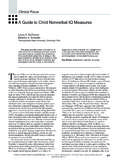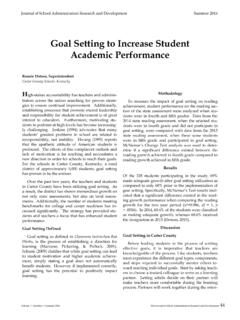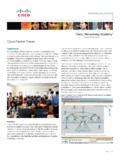Transcription of Section 29. Instruction Set - Microchip Technology
1 M. Section 29. Instruction Set HIGHLIGHTS. This Section of the manual contains the following major topics: Introduction ..29-2. Instruction Formats ..29-4. Special Function Registers as Source/Destination ..29-6. Q Cycle Instruction Design Tips ..29-45. Related Application Revision History ..29-48. 29. Instruction Set 1997 Microchip Technology Inc. DS31029A page 29-1. PICmicro MID-RANGE MCU FAMILY. Introduction Each midrange Instruction is a 14-bit word divided into an OPCODE which specifies the instruc - tion type and one or more operands which further specify the operation of the Instruction . The midrange Instruction Set Summary in Table 29-1 lists the instructions recognized by the MPASM. assembler. The Instruction set is highly orthogonal and is grouped into three basic categories: Byte-oriented operations Bit-oriented operations Literal and control operations Table 29-2 gives the opcode field descriptions.
2 For byte-oriented instructions , 'f' represents a file register designator and 'd' represents a des- tination designator. The file register designator specifies which file register is to be used by the Instruction . The destination designator specifies where the result of the operation is to be placed. If 'd' is zero, the result is placed in the W register. If 'd' is one, the result is placed in the file register specified in the Instruction . For bit-oriented instructions , 'b' represents a bit field designator which selects the number of the bit affected by the operation, while 'f' represents the number of the file in which the bit is located. For literal and control operations, 'k' represents an eight or eleven bit constant or literal value. All instructions are executed in one single Instruction cycle, unless a conditional test is true or the program counter is changed as a result of an Instruction .
3 In these cases, the execution takes two Instruction cycles with the second cycle executed as an NOP. One Instruction cycle consists of four oscillator periods. Thus, for an oscillator frequency of 4 MHz, the normal Instruction execu- tion time is 1 s. If a conditional test is true or the program counter is changed as a result of an Instruction , the Instruction execution time is 2 s. DS31029A-page 29-2 1997 Microchip Technology Inc. Section 29. Instruction Set Table 29-1: Midrange Instruction Set Mnemonic, 14-Bit Instruction Word Status Description Cycles Notes Operands MSb LSb Affected BYTE-ORIENTED FILE REGISTER OPERATIONS. ADDWF f, d Add W and f 1 00 0111 dfff ffff C,DC,Z 1,2. ANDWF f, d AND W with f 1 00 0101 dfff ffff Z 1,2. CLRF f Clear f 1 00 0001 lfff ffff Z 2. CLRW - Clear W 1 00 0001 0xxx xxxx Z. COMF f, d Complement f 1 00 1001 dfff ffff Z 1,2. DECF f, d Decrement f 1 00 0011 dfff ffff Z 1,2.
4 DECFSZ f, d Decrement f, Skip if 0 1(2) 00 1011 dfff ffff 1,2,3. INCF f, d Increment f 1 00 1010 dfff ffff Z 1,2. INCFSZ f, d Increment f, Skip if 0 1(2) 00 1111 dfff ffff 1,2,3. IORWF f, d Inclusive OR W with f 1 00 0100 dfff ffff Z 1,2. MOVF f, d Move f 1 00 1000 dfff ffff Z 1,2. MOVWF f Move W to f 1 00 0000 lfff ffff NOP - No Operation 1 00 0000 0xx0 0000. RLF f, d Rotate Left f through Carry 1 00 1101 dfff ffff C 1,2. RRF f, d Rotate Right f through Carry 1 00 1100 dfff ffff C 1,2. SUBWF f, d Subtract W from f 1 00 0010 dfff ffff C,DC,Z 1,2. SWAPF f, d Swap nibbles in f 1 00 1110 dfff ffff 1,2. XORWF f, d Exclusive OR W with f 1 00 0110 dfff ffff Z 1,2. BIT-ORIENTED FILE REGISTER OPERATIONS. BCF f, b Bit Clear f 1 01 00bb bfff ffff 1,2. BSF f, b Bit Set f 1 01 01bb bfff ffff 1,2. BTFSC f, b Bit Test f, Skip if Clear 1 (2) 01 10bb bfff ffff 3. BTFSS f, b Bit Test f, Skip if Set 1 (2) 01 11bb bfff ffff 3.
5 LITERAL AND CONTROL OPERATIONS. ADDLW k Add literal and W 1 11 111x kkkk kkkk C,DC,Z. ANDLW k AND literal with W 1 11 1001 kkkk kkkk Z. CALL k Call subroutine 2 10 0kkk kkkk kkkk CLRWDT - Clear Watchdog Timer 1 00 0000 0110 0100 TO,PD. GOTO k Go to address 2 10 1kkk kkkk kkkk IORLW k Inclusive OR literal with W 1 11 1000 kkkk kkkk Z. MOVLW k Move literal to W 1 11 00xx kkkk kkkk RETFIE - Return from interrupt 2 00 0000 0000 1001 29. RETLW k Return with literal in W 2 11 01xx kkkk kkkk RETURN - Return from Subroutine 2 00 0000 0000 1000. SLEEP - Go into standby mode 1 00 0000 0110 0011 TO,PD. Instruction SUBLW k Subtract W from literal 1 11 110x kkkk kkkk C,DC,Z. XORLW k Exclusive OR literal with W 1 11 1010 kkkk kkkk Z. Set Note 1: When an I/O register is modified as a function of itself ( , MOVF PORTB, 1), the value used will be that value present on the pins themselves. For example, if the data latch is '1' for a pin configured as input and is driven low by an external device, the data will be written back with a '0'.
6 2: If this Instruction is executed on the TMR0 register (and, where applicable, d = 1), the prescaler will be cleared if assigned to the Timer0 Module. 3: If Program Counter (PC) is modified or a conditional test is true, the Instruction requires two cycles. The sec- ond cycle is executed as a NOP. 1997 Microchip Technology Inc. DS31029A-page 29-3. PICmicro MID-RANGE MCU FAMILY. Instruction Formats Figure 29-1 shows the three general formats that the instructions can have. As can be seen from the general format of the instructions , the opcode portion of the Instruction word varies from 3-bits to 6-bits of information. This is what allows the midrange Instruction set to have 35 instruc - tions. Note 1: Any unused opcode is Reserved. Use of any reserved opcode may cause unex- pected operation. Note 2: To maintain upward compatibility with future midrange products, do not use the OPTION and TRIS instructions .
7 All Instruction examples use the following format to represent a hexadecimal number: 0xhh where h signifies a hexadecimal digit. To represent a binary number: 00000100b where b is a binary string identifier. Figure 29-1: General Format for instructions Byte-oriented file register operations 13 8 7 6 0. OPCODE d f (FILE #). d = 0 for destination W. d = 1 for destination f f = 7-bit file register address Bit-oriented file register operations 13 10 9 7 6 0. OPCODE b (BIT #) f (FILE #). b = 3-bit bit address f = 7-bit file register address Literal and control operations General 13 8 7 0. OPCODE k (literal). k = 8-bit literal (immediate) value CALL and GOTO instructions only 13 11 10 0. OPCODE k (literal). k = 11-bit literal (immediate) value DS31029A-page 29-4 1997 Microchip Technology Inc. Section 29. Instruction Set Table 29-2: Instruction Description Conventions Field Description f Register file address (0x00 to 0x7F).
8 W Working register (accumulator). b Bit address within an 8-bit file register (0 to 7). k Literal field, constant data or label (may be either an 8-bit or an 11-bit value). x Don't care (0 or 1). The assembler will generate code with x = 0. It is the recommended form of use for compatibility with all Microchip software tools. d Destination select;. d = 0: store result in W, d = 1: store result in file register f. dest Destination either the W register or the specified register file location label Label name TOS Top of Stack PC Program Counter PCLATH Program Counter High Latch GIE Global Interrupt Enable bit WDT Watchdog Timer TO Time-out bit PD Power-down bit [ ] Optional ( ) Contents Assigned to <> Register bit field In the set of italics User defined term (font is courier). 29. Instruction Set 1997 Microchip Technology Inc. DS31029A-page 29-5. PICmicro MID-RANGE MCU FAMILY.
9 Special Function Registers as Source/Destination The Section 29. Instruction Set's orthogonal Instruction set allows read and write of all file regis- ters, including special function registers. Some special situations the user should be aware of are explained in the following subsections: STATUS Register as Destination If an Instruction writes to the STATUS register, the Z, C, DC and OV bits may be set or cleared as a result of the Instruction and overwrite the original data bits written. For example, executing CLRF STATUS will clear register STATUS, and then set the Z bit leaving 0000 0100b in the reg- ister. PCL as Source or Destination Read, write or read-modify-write on PCL may have the following results: Read PC: PCL dest; PCLATH does not change;. Write PCL: PCLATH PCH;. 8-bit destination value PCL. Read-Modify-Write: PCL ALU operand PCLATH PCH;. 8-bit result PCL. Where PCH = program counter high byte (not an addressable register), PCLATH = Program counter high holding latch, dest = destination, W register or register file f.
10 Bit Manipulation All bit manipulation instructions will first read the entire register, operate on the selected bit and then write the result back (read-modify-write (R-M-W)) the specified register. The user should keep this in mind when operating on some special function registers, such as ports. Note: Status bits that are manipulated by the device (including the interrupt flag bits) are set or cleared in the Q1 cycle. So there is no issue with executing R-M-W instructions on registers which contain these bits. DS31029A-page 29-6 1997 Microchip Technology Inc. Section 29. Instruction Set Q Cycle Activity Each Instruction cycle (Tcy) is comprised of four Q cycles (Q1-Q4). The Q cycle is the same as the device oscillator cycle (TOSC). The Q cycles provide the timing/designation for the Decode, Read, Process Data, Write etc., of each Instruction cycle. The following diagram shows the rela- tionship of the Q cycles to the Instruction cycle.

















